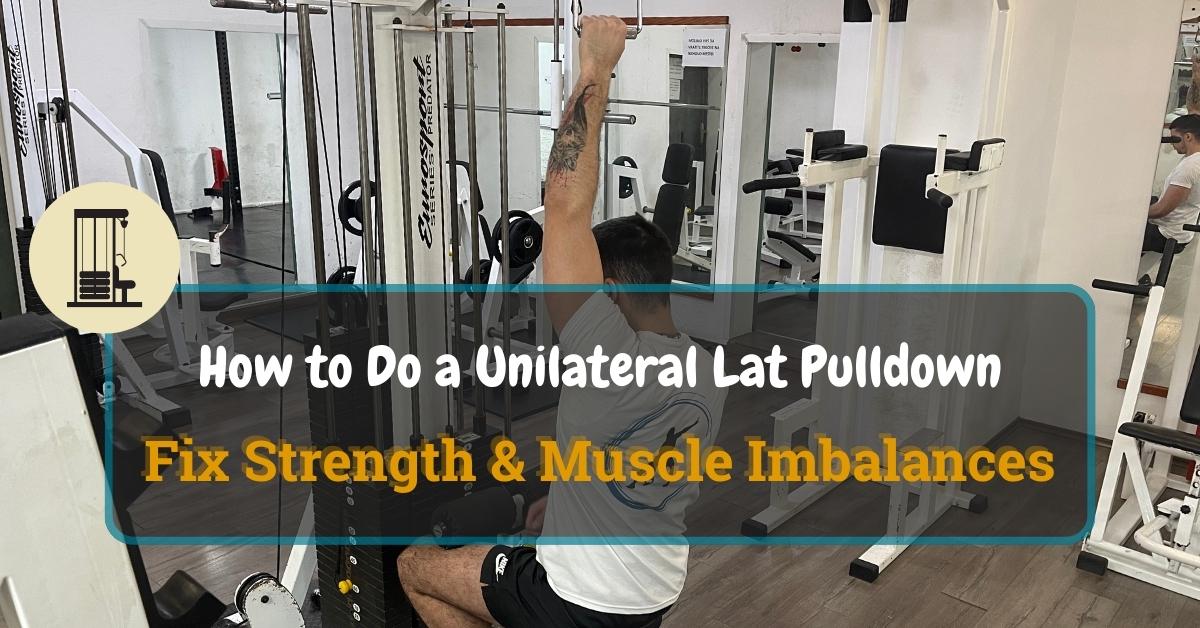The unilateral lat pulldown is one of the best pulling exercises for targeting your lats.
Table of Contents
ToggleIn my experience, I have seen unilateral lat pulldowns used even amongst kinesiology therapists with clients who have functional thoracic scoliosis and kyphosis.
This clearly points out how useful a single-arm lat pulldown can be for correcting strength and muscle imbalances.
In fact, a study from PubMed Central titled “The Effects of Individualized Resistance Strength Programs on Knee Muscular Imbalances in Junior Elite Soccer Players” indicates that individualized resistance training programs could provide additional benefits to traditional strength training protocols to improve muscular imbalances in post-adolescent soccer players [1].
Below, I prepared a simple guide that will teach you every step of the way to perform a unilateral lat pulldown without any injuries.
Start Building Your Dream Body Today
Ready to elevate your fitness game without falling into the trap of dull, repetitive routines that just don’t deliver? Imagine sculpting your ideal physique and boosting your health, all while still enjoying life’s pleasures, like those irresistible weekend getaways and your aunt’s legendary cheesecake. With our online fitness and nutrition coaching service, you don’t have to compromise. Dive into a personalized fitness journey that blends perfectly with your lifestyle, not against it. Book your completely free discovery consultation today, and take the first step towards a transformation that doesn’t require giving up the joys of life.

“I was skeptical about online fitness coaching, but Functional Body Savage completely changed my perspective. Vanja and Radomir’s personalized approach and attention to detail have helped me achieve goals I never thought possible. I’m stronger, more confident, and grateful for their guidance.”
Emily Thompson, San Francisco, CA
Learn More About Our Online Coaching ServiceQuick Summary
- To perform a unilateral lat pulldown, begin with the correct setup on the machine, pull the handle towards your upper chest with one arm, and ensure controlled movement throughout.
- The unilateral lat pulldown targets the latissimus dorsi as the primary muscle, with biceps, forearm flexors, trapezius, rhomboids, and core muscles as secondary muscles.
- A study from PubMed Central indicated that both groups in an 8-week training program experienced muscle mass increases ranging from 6.7% to 12.9% across different muscle measurement sites.
- After years of specialized training and practice, I am certain that incorporating both unilateral and bilateral pulldowns in a workout regime optimizes lat development and overall muscle growth.
How to Do a Unilateral Lat Pulldown
Here is how to perform a single arm lat pulldown to maximize performance and minimize the chance of injury.
Step One — Assume the Starting Position on the Lat Pulldown Machine
Begin with the correct setup on the machine. Adjust the knee pad of the machine so that it snugly fits over your thighs, preventing your body from being lifted during the exercise.
Sit down on the machine seat and grasp the handle with one hand. Your grip should be firm yet comfortable, and your arm should be fully extended upward. Ensure your torso is upright and your shoulders are relaxed. This starting position is crucial for an effective and safe unilateral lat pulldown.
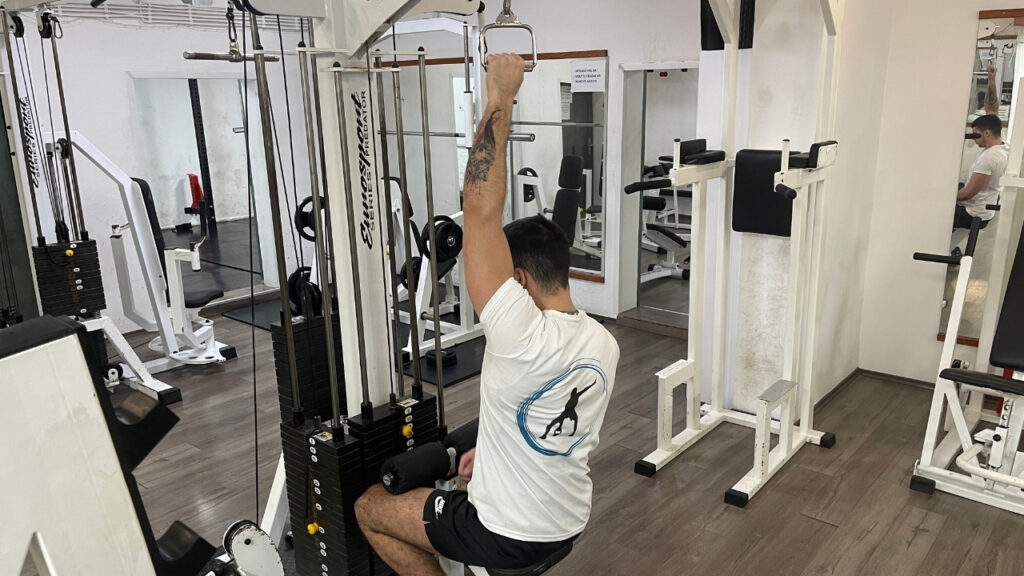
Pro Tip: Focus on deep, controlled breathing as you set up. Proper breathing helps maintain a stable core and reduces the risk of injury.
Step Two — Pull the Handle Towards Your Body by Bending Your Arm
Now, initiate the pull by driving your elbow down toward the floor. The movement should be controlled and focused, with the elbow leading the motion. As you pull the handle down, aim to bring it towards your upper chest.
Keep your torso steady; avoid leaning backward to assist in the pull. This phase of the exercise emphasizes the lat muscles, engaging them fully as you pull.

Pro Tip: Visualize your lat muscles contracting as you pull down. This mind-muscle connection enhances muscle activation and effectiveness.
Step Three — Slowly Return the Handle by Extending Your Arm
After pulling the handle down, it’s important to focus on the return phase. Slowly allow the handle to go back up as you extend your arm. This controlled movement helps work the muscles during the eccentric or negative phase of the exercise.
Ensure that your movement is smooth and steady, and avoid letting the weight stack crash. This phase is as crucial as the pulling phase and contributes significantly to muscle strength and growth.
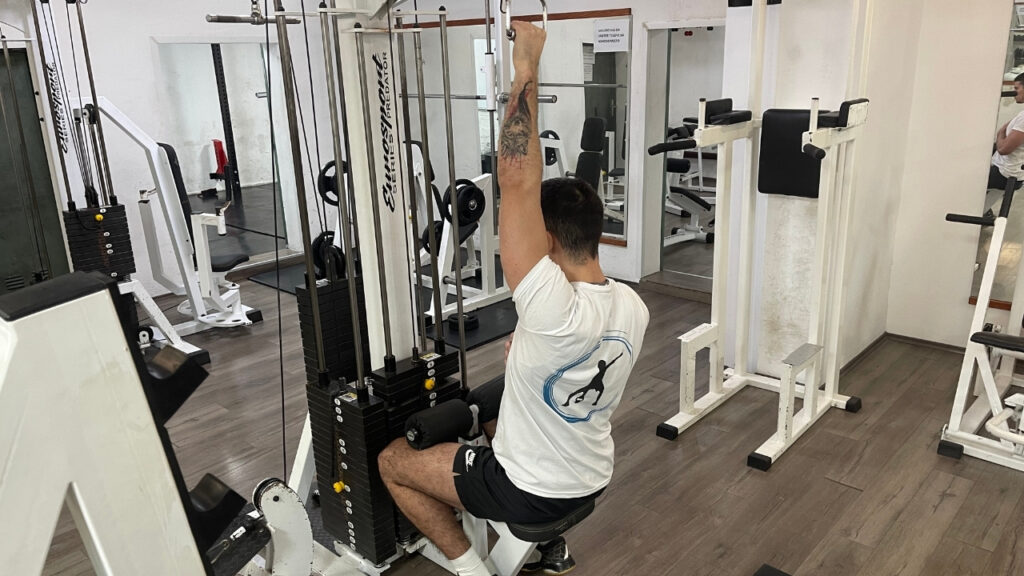
Pro Tip: Concentrate on the sensation of the muscle lengthening as you return to the starting position to maximize the benefit of the eccentric phase.
Unilateral Lat Pulldown vs Lat Pulldown: Which Is Better for Lat Width?
While searching for the perfect method and exercise to enhance lat width, I’ve explored both unilateral and bilateral lat pulldowns extensively. Here’s my take on which one offers better development based on my personal workouts and observations.
Unilateral Lat Pulldown
The unilateral lat pulldown, performed one arm at a time, offers a unique advantage in terms of muscle engagement and balance. This exercise allows for a greater range of motion and a more focused contraction on each side of the body.
It’s especially beneficial for identifying and correcting muscle imbalances, as each side of the latissimus dorsi is worked independently.
This focused approach can lead to more symmetrical muscle development and can be particularly useful for individuals who have experienced a unilateral injury or have a dominant side that tends to take over in bilateral exercises.

Bilateral Lat Pulldown
The traditional bilateral lat pulldown, performed with both arms simultaneously, is excellent for building overall muscle mass and strength in the latissimus dorsi. This exercise allows for the use of heavier weights, contributing to increased muscle hypertrophy and strength gains.
However, it can sometimes mask muscle imbalances, as the stronger side might compensate for the weaker one.
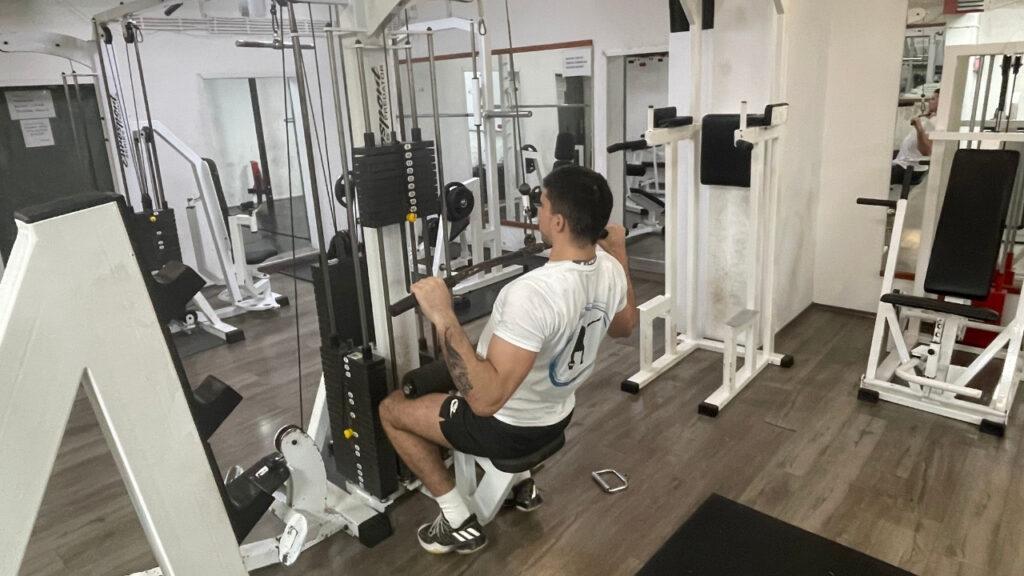
Which Is Better for Lat Width?
For individuals aiming to increase lat width, incorporating both unilateral and bilateral lat pulldowns into a workout routine can be the most effective approach.
The unilateral lat pulldown hones in on each side’s specific needs, enhancing muscle symmetry and individual muscle strength. In contrast, the bilateral lat pulldown allows for heavier lifting, which is crucial for overall muscle growth and development.
I’ve personally experienced better gains in terms of lat width with the good old bilateral lat pulldowns.
Why?
Well, I assume that I can lift more weight and increase the intensity a lot easier. This doesn’t mean that it will be the same for you, but my experience has led me to believe that two-handed variation is much better for muscle hypertrophy. Another thing is that you can grip the bar much wider with the bilateral version. This definitely adds to the width of your lats.
Unilateral Lat Pulldown Muscles Worked
Based on my biomechanical analysis of the unilateral lat pulldown movement, here are the primary muscles working:
- Latissimus Dorsi: The primary target, this broad muscle extends across the mid to lower back, playing a key role in shoulder movement and spine stability.
And here are the secondary muscles working:
- Biceps and forearm flexors
- Trapezius and rhomboids
- Core muscles (abs and obliques)
Unilateral Lat Pulldown Benefits
The unilateral lat pulldown is more than just a variant of its bilateral counterpart. It’s a strategic exercise that brings a host of unique benefits to your fitness regimen.
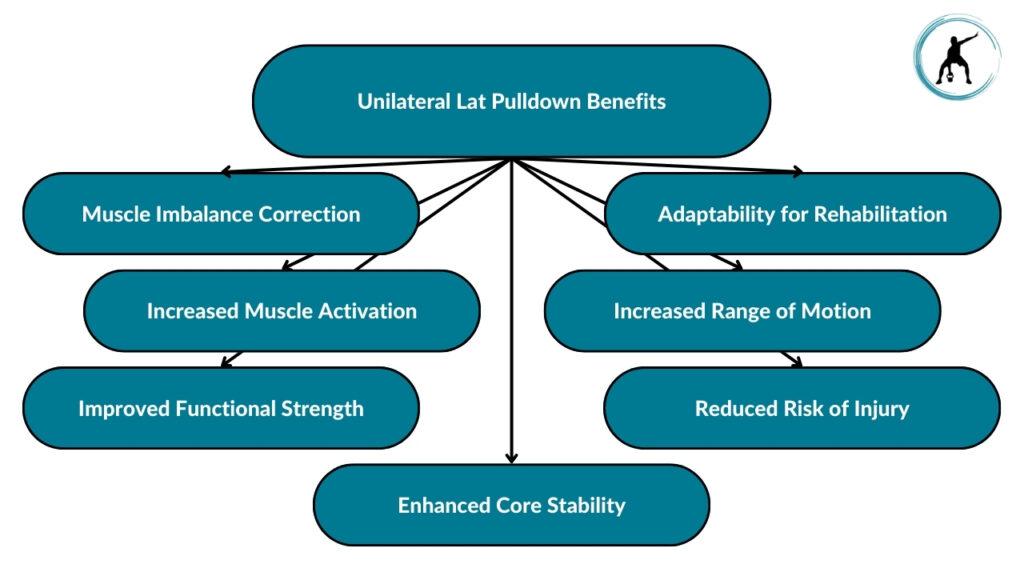
Muscle Imbalance Correction
This exercise excels in its ability to isolate each side of your body, offering a focused approach to training. It’s particularly effective for athletes who have developed one side more than the other due to specific sports or activities. This was definitely the case with me since I played basketball, and my lead hand, the one I would shoot with, was much stronger.
Regular practice can lead to a more balanced physique and enhanced overall muscle symmetry.
Increased Muscle Activation
By working one side at a time, this exercise requires more stabilization and concentration, leading to heightened muscle activation. This increased engagement not only stimulates the primary muscles more effectively but also involves secondary muscle groups more intensively, enhancing muscle development and functional strength.
Improved Functional Strength
From my experience, incorporating unilateral lat pulldowns has had a noticeable impact on my day-to-day activities. Tasks that require lifting or pulling with one arm, like carrying groceries or opening a heavy door, have become noticeably easier.
This exercise closely mirrors the unilateral nature of many real-world movements, improving my ability to perform them with greater ease and strength.
Enhanced Core Stability
The unilateral aspect of this exercise demands significant core strength to maintain balance and proper form. It engages the abs and obliques more dynamically than bilateral movements, leading to a stronger, more stable core, which is essential for overall athletic performance.
Reduced Risk of Injury
By promoting muscle balance and enhancing stability, the unilateral lat pulldown contributes to a reduced risk of injury. Balanced muscle development ensures that no single muscle group is overcompensated, decreasing the likelihood of strain or injury during other exercises and daily activities.
Increased Range of Motion
The freedom of movement in a unilateral exercise allows for a more extensive range of motion. This greater stretch and contraction of the muscles enhance flexibility and muscle development, contributing to better posture and muscle health.
Adaptability for Rehabilitation
During a period of rehabilitation following a shoulder injury, I found the unilateral lat pulldown to be particularly beneficial. The ability to work each side independently allowed me to maintain strength in my uninjured side while gradually and safely rebuilding strength in my injured shoulder, facilitating a more balanced and effective recovery.
What Are the Best Tips for Performing Single-Arm Lat Pulldowns?
Performing unilateral lat pulldowns effectively requires attention to detail and proper technique. Here are some essential tips to ensure you get the most out of this exercise.
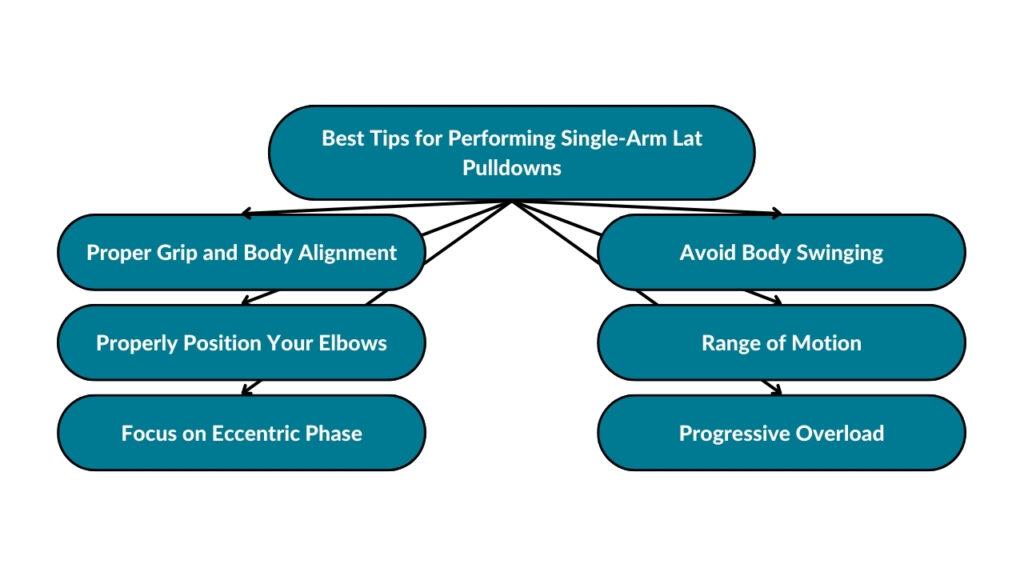
Proper Grip and Body Alignment
Begin by gripping the handle firmly but not too tightly. Your body should be aligned with your spine straight, and core engaged. This alignment is crucial for maximizing muscle engagement and avoiding strain.
Properly Position Your Elbows
Your elbows should play a pivotal role in the movement. They should move straight down and back, aligning with your body’s natural movement. This ensures effective targeting of the lat muscles without undue stress on the shoulder joints.
Focus on Eccentric Phase
The eccentric, or lowering phase, of the lat pulldown is as important as the pulling phase. Control the movement as you return to the start position to maximize muscle tension and growth.
Avoid Body Swinging
It’s common to see people swinging their bodies to generate momentum, especially with heavier weights. Avoid this by keeping your core engaged and focusing on moving only your arms. This isolation ensures that your lats are doing the work.
Range of Motion
Aim for a full range of motion in each rep. This means fully extending your arm at the top and bringing the handle close to your chest at the bottom. A full range ensures maximum muscle activation and growth.
Progressive Overload
Like any other exercise, progressive overload is key to muscle development. Gradually increase the weight or reps over time to challenge your muscles and encourage growth.
One of the studies from PubMed Central titled “Progressive overload without progressing load? The effects of load or repetition progression on muscular adaptations” found that both progressions of repetitions and load appear to be viable strategies for enhancing muscular adaptations over an 8-week training cycle [2].
What Are the Most Common Mistakes During Single-Arm Lat Pulldowns?
Even experienced gym-goers can fall prey to common mistakes when performing single-arm lat pulldowns. Being aware of these errors can help you avoid them, ensuring a safer and more effective workout. Based on my experience, here are some of the most frequent missteps you must be aware of before starting with unilateral lat pulldowns.
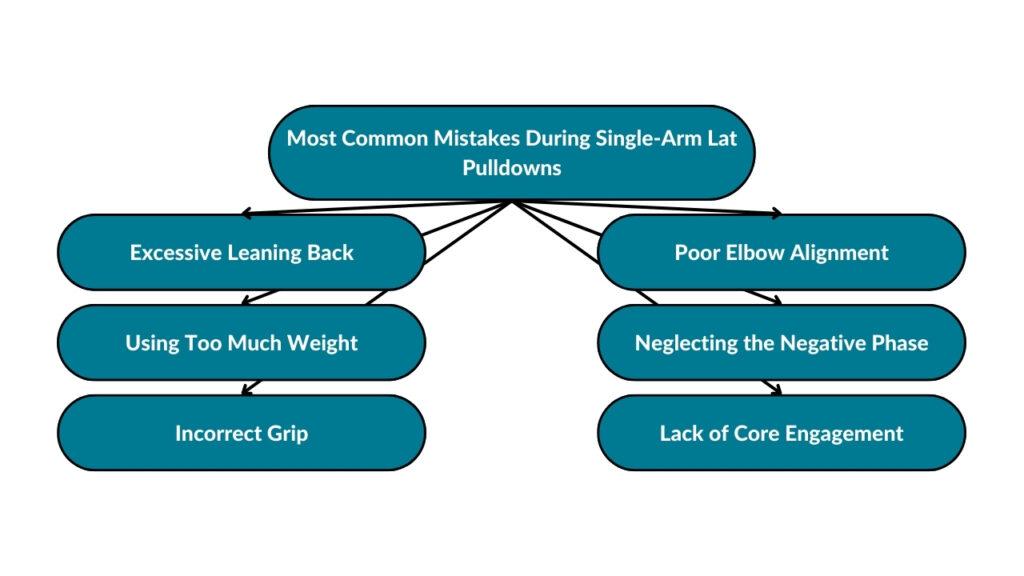
Excessive Leaning Back
A slight lean is acceptable, but excessive leaning back turns the exercise into a rowing motion, which shifts the focus away from the lats. Maintain an upright posture to ensure you’re targeting the right muscles.
Using Too Much Weight
Lifting heavier than you can manage often leads to compromised form. It’s better to use a weight that allows you to perform the exercise with the proper technique, ensuring targeted muscle activation and reducing the risk of injury.
Incorrect Grip
A grip that’s too wide or too narrow can affect muscle engagement. Ensure your grip is just outside shoulder width to optimize lat activation.
Poor Elbow Alignment
Your elbows should move in a path that maximizes lat engagement, typically in a slightly backward arc. Misaligned elbows can reduce the effectiveness of the exercise and increase the risk of injury.
Neglecting the Negative Phase
Rushing through the eccentric (lowering) phase of the exercise reduces its effectiveness. Control the descent to maximize muscle tension and growth.
Lack of Core Engagement
Failing to engage your core can lead to instability and reduced effectiveness. A braced core helps maintain proper form and supports your spine.
Unilateral Lat Pulldown Variations
Here are some of the best unilateral lat pulldown variations.
Single-Arm Resistance Band Lat Pulldown
Ideal for home workouts, this variation uses a resistance band to simulate the lat pulldown movement, offering continuous tension throughout the exercise.
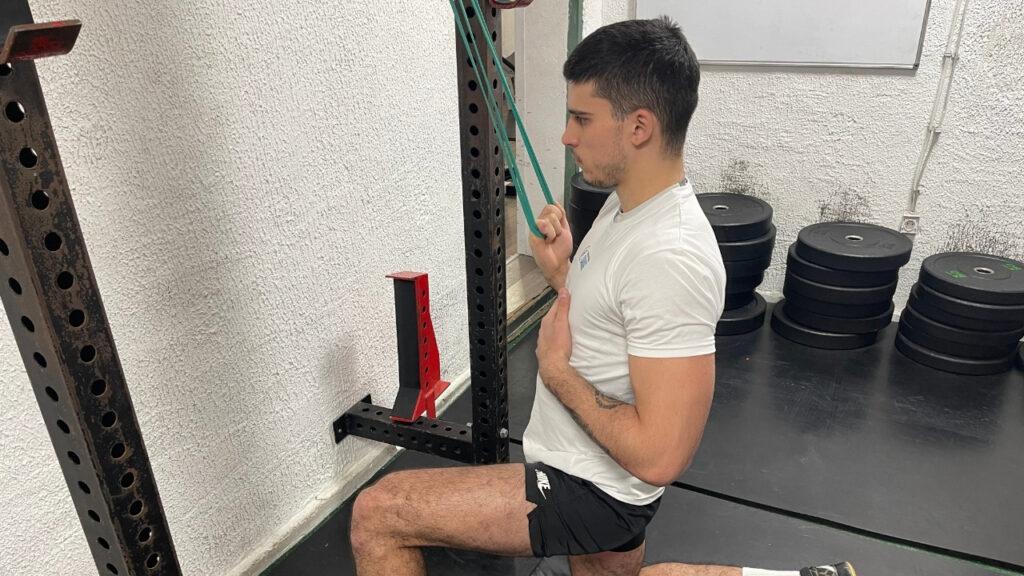
Steps:
- Secure a resistance band to a high anchor point.
- Grasp the band with one hand, arm extended upward.
- Kneel or sit with your body aligned under the anchor point.
- Pull the band down smoothly towards your upper chest.
- Slowly return to the starting position, maintaining tension on the band.
Pro Tip: Focus on maintaining a steady tempo; avoid letting the band snap back to encourage controlled muscle engagement.
Single-Arm Dumbbell Pullover
From my experience, the single-arm dumbbell pullover has been a game-changer for targeting my lats with a unique stretch and pull motion.
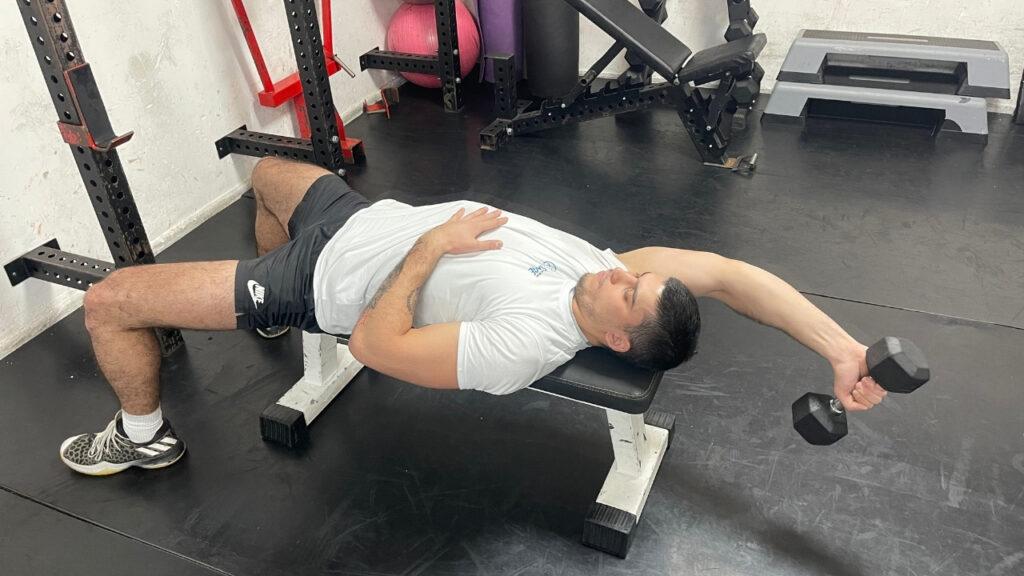
Steps:
- Lie on a flat bench, holding a dumbbell with one hand above your chest.
- Keep your arm slightly bent throughout the movement.
- Slowly lower the dumbbell back and over your head, stretching the lats.
- Pull the dumbbell back to the starting position using your lats.
- Keep your hips and lower back stable on the bench throughout the exercise.
Pro Tip: Enhance the lat stretch by focusing on a full range of motion and using a weight that allows for controlled movement.
Kneeling Single-Arm Lat Pulldown
Performed while kneeling, this variation changes the angle of the pull and intensifies the core engagement.

Steps:
- Kneel in front of a lat pulldown machine with one knee down.
- Grasp the handle with one hand, arm extended.
- Pull the handle down towards your chest, keeping your core tight.
- Focus on driving the movement with your elbow.
- Slowly extend your arm back to the starting position.
Pro Tip: Engage your glutes and core throughout the exercise to maintain stability and enhance muscle isolation.
Chest-Supported Unilateral Lat Pulldown
This variation, performed on an inclined bench, provides back support that isolates the lats and minimizes body movement.
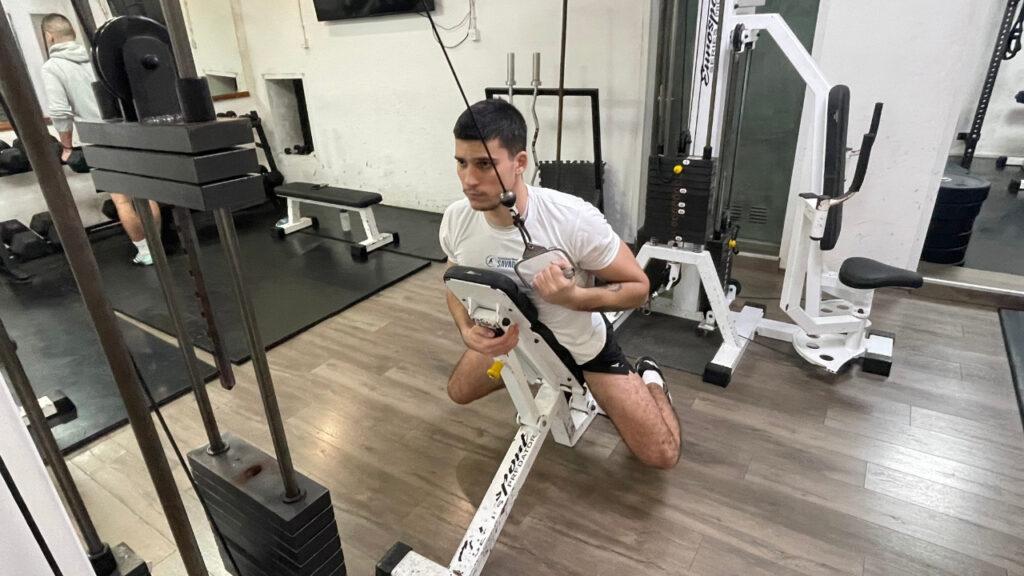
Steps:
- Set an incline bench at about a 45-degree angle.
- Lie face down with your chest on the bench.
- Grasp a pulldown handle with one hand.
- Pull the handle towards your side, focusing on contracting your lat.
- Slowly return to the starting position, maintaining control.
Pro Tip: Ensure that your movements are slow and deliberate to prevent using momentum, maximizing lat engagement.
Unilateral Lat Pulldown Alternative Exercises
Let’s see some alternative exercises you can implement in your workout routine.
Single-Arm Dumbbell Row
This exercise allows for a significant range of motion and intense focus on the lats.
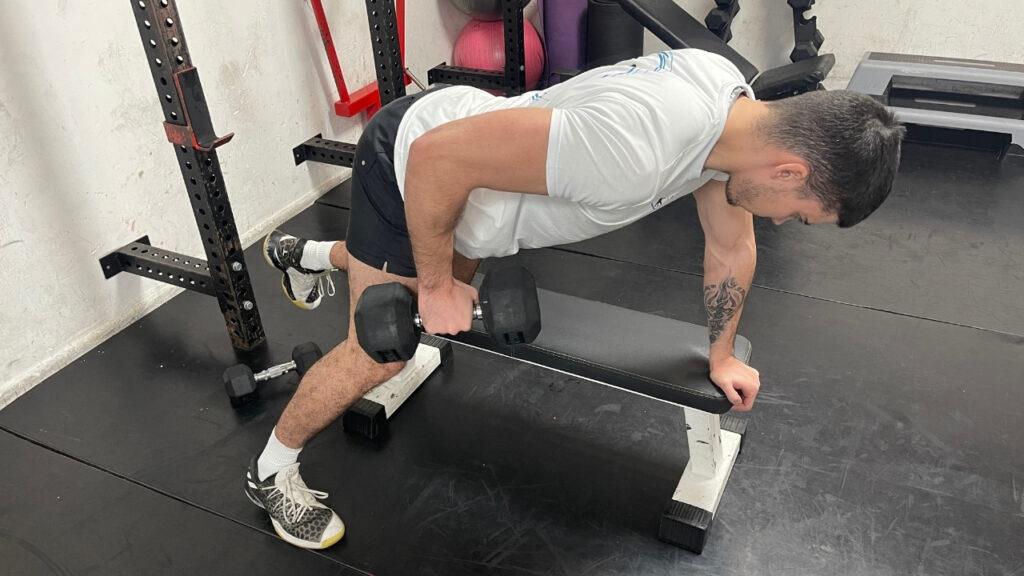
Steps:
- Place one knee and hand on a bench, keeping your back flat and parallel to the floor.
- Hold a dumbbell in your free hand with an overhand grip.
- Lift the dumbbell towards your hip, keeping your elbow close to your body.
- Lower the dumbbell slowly back to the starting position.
- Maintain a stable torso throughout the exercise to isolate the lats.
Pro Tip: Focus on squeezing your shoulder blade towards your spine at the top of the movement for maximum lat engagement.
Single-Arm Cable Row
This exercise emphasizes constant tension on the lats and offers a different resistance curve compared to free weights.
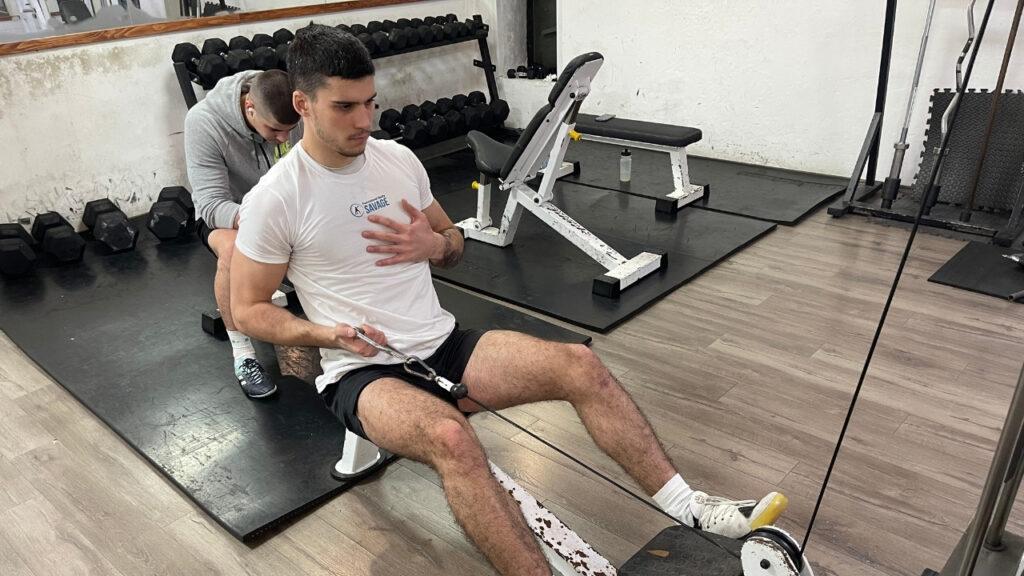
Steps:
- Sit at a low cable row machine with your feet braced.
- Grasp the handle with one hand, keeping your back straight.
- Pull the handle towards your waist, driving the movement with your elbow.
- Extend your arm slowly to return to the starting position.
- Keep your torso stationary throughout the exercise.
Pro Tip: Experiment with different hand positions (palms facing up, down, or neutral) to engage different parts of the lats.
Single-Arm Resistance Band Row
A versatile and joint-friendly alternative, perfect for home workouts or those seeking a lower-impact option.
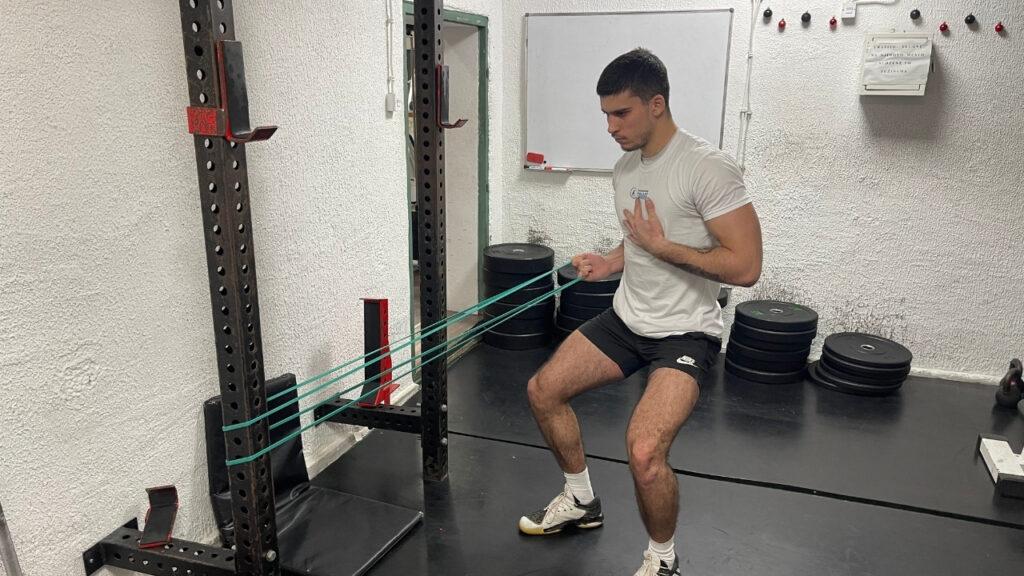
Steps:
- Anchor a resistance band below the chest level.
- Stand or sit, facing the band, and hold it with one hand.
- Pull the band towards your side, keeping your elbow close to your body.
- Slowly return to the starting position, maintaining tension on the band.
- Ensure a controlled movement throughout the exercise.
Pro Tip: Increase the intensity by stepping further away from the anchor point, adding more resistance to the exercise.
Applied Kinesiology: Implementing Modified Unilateral Lat Pulldowns to Treat Functional Thoracic Scoliosis and Kyphosis
In applied kinesiology, specific exercises are often used therapeutically to address and alleviate the symptoms of conditions like functional thoracic scoliosis and kyphosis. Modified unilateral lat pulldowns can play a significant role in such treatment plans.
Modified Unilateral Lat Pulldowns for Functional Thoracic Scoliosis
This exercise variation is tailored for individuals with functional thoracic scoliosis. It emphasizes strengthening the elongated side of the back, which is essential for addressing scoliosis-specific imbalances.
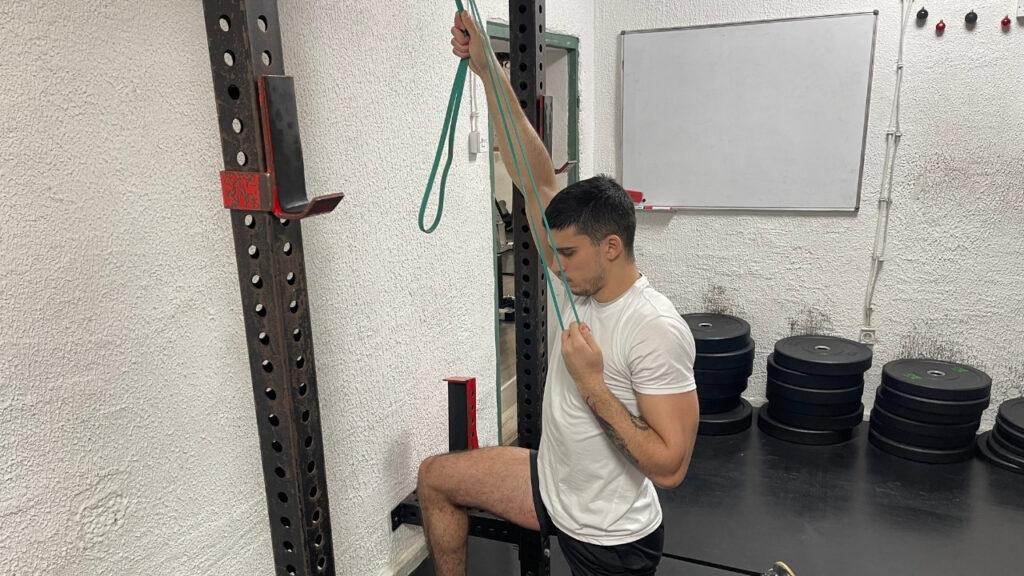
Steps:
- Attach a resistance band to a high position above you.
- For left-side scoliosis, use your left arm as the working arm, and vice versa for right-side scoliosis.
- Extend your non-working arm fully overhead, holding the band to create tension.
- Perform the lat pulldown with your working arm while keeping the other arm extended.
- Focus on controlled, steady movements, ensuring the working side is engaged effectively.
Pro Tip: Ensure that the elongated side (non-working arm) remains fully extended and stretched throughout the exercise to enhance muscular balance and address the asymmetry typical in scoliosis.
Modified Single-Arm Resistance Band Lat Pulldowns for Functional Kyphosis
This modified exercise is designed to strengthen the upper back muscles, which are crucial for improving posture in individuals with functional kyphosis.
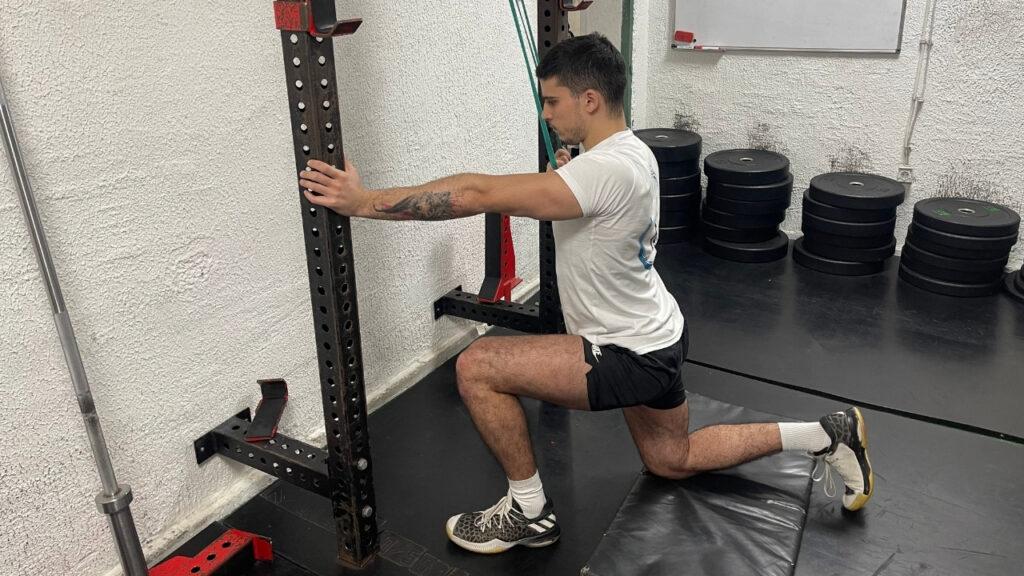
Steps:
- Secure a resistance band at an overhead anchor point.
- Extend the non-working arm in front of you, retracting the scapula of that arm.
- With your working arm, perform the resistance band pulldown.
- Maintain the scapular retraction and forward extension of the non-working arm throughout.
- Focus on a controlled, fluid motion, ensuring the working arm is fully engaged.
Pro Tip: Emphasize scapular retraction and chest opening on the non-working side to maximize the postural benefits of the exercise for kyphosis.
Here is another variation of the same exercise:
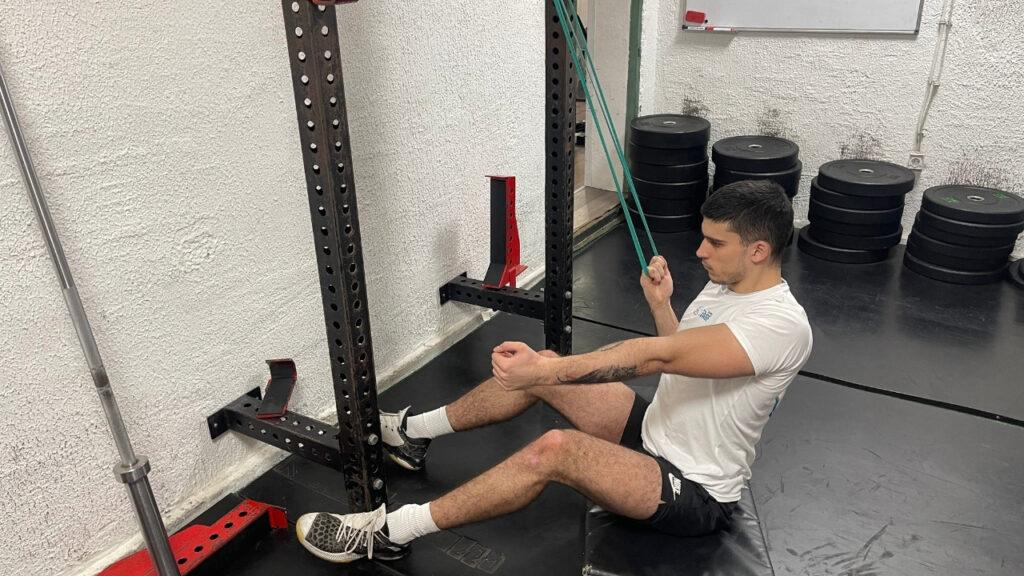
FAQs
What Is a Good Weight for a One Arm Lat Pulldown?
A good weight for a one-arm lat pulldown is subjective, varying according to an individual’s strength and experience levels. It is advisable to start with a manageable weight that enables proper execution of 8-12 repetitions; if this range is completed with ease, incrementally increasing the weight is recommended for further challenge and muscle development.
How Do You Isolate a Single Lat?
To effectively isolate a single lat during exercises such as the one-arm lat pulldown, it’s crucial to concentrate on initiating the movement through the elbow while actively engaging the lat muscle. Ensuring correct body posture and avoiding compensatory movements, like twisting of the torso, is vital for targeted muscle engagement and injury prevention.
Should I Only Do Unilateral Exercises?
No, you shouldn’t only do unilateral exercises. Incorporating a mix of both unilateral and bilateral exercises is essential for comprehensive muscle development and maintaining overall muscular balance.
What Is the Difference Between Bilateral and Unilateral Pulldowns?
The primary difference between bilateral and unilateral pulldowns lies in their execution: bilateral pulldowns are performed using both arms simultaneously, offering benefits in overall strength and muscle mass building. In contrast, unilateral pulldowns are executed with one arm at a time, providing enhanced focus on each side of the body, aiding in correcting imbalances, and potentially increasing muscle activation.
What Role Do Unilateral Lat Pulldowns Play in Injury Prevention and Rehabilitation?
Unilateral lat pulldowns play a significant role in injury prevention and rehabilitation by promoting balanced development of the latissimus dorsi, trapezius, biceps, and rear deltoids. They reduce the risk of muscle imbalances, such as uneven strength between the left and right sides or disproportionate development between the upper and lower back muscles.
What Is the Importance of Integrating Unilateral Lat Pulldowns in Workout Routines?
The importance of integrating unilateral lat pulldowns in workout routines is evident in their targeted impact on specific muscle groups, namely the latissimus dorsi, biceps, and rear deltoids. By focusing on these muscles, unilateral lat pulldowns help in achieving a balanced development between both sides of the body and between different muscle groups within the back, contributing to overall back strength and symmetry.
Wrapping Up
In this comprehensive guide, we’ve explored the unilateral lat pulldown in depth – from its basic execution to its variations and the role it plays in addressing specific conditions like functional thoracic scoliosis and kyphosis. We’ve delved into the muscles involved, compared it with traditional lat pulldowns, and provided practical tips and common mistakes to help you optimize your workout.
Whether you’re looking to correct muscle imbalances, enhance functional strength, or simply diversify your back workout routine, the unilateral lat pulldown offers a range of benefits. Its variations and adaptations make it a versatile and effective tool in your fitness arsenal.
Remember, the key to success in any exercise regimen is consistency, proper technique, and a balanced approach. As you incorporate these exercises into your routine, listen to your body, focus on form, and gradually increase intensity for the best results.
For those seeking to expand their knowledge and enhance their workout routines further, exploring more unilateral exercises or diving deeper into applied kinesiology principles can be the next steps in your fitness journey.
Start Building Your Dream Body Today
Ready to elevate your fitness game without falling into the trap of dull, repetitive routines that just don’t deliver? Imagine sculpting your ideal physique and boosting your health, all while still enjoying life’s pleasures, like those irresistible weekend getaways and your aunt’s legendary cheesecake. With our online fitness and nutrition coaching service, you don’t have to compromise. Dive into a personalized fitness journey that blends perfectly with your lifestyle, not against it. Book your completely free discovery consultation today, and take the first step towards a transformation that doesn’t require giving up the joys of life.

“I was skeptical about online fitness coaching, but Functional Body Savage completely changed my perspective. Vanja and Radomir’s personalized approach and attention to detail have helped me achieve goals I never thought possible. I’m stronger, more confident, and grateful for their guidance.”
Emily Thompson, San Francisco, CA
Learn More About Our Online Coaching ServiceReferences:
- Śliwowski R, Jadczak Ł, Hejna R, Wieczorek A. The Effects of Individualized Resistance Strength Programs on Knee Muscular Imbalances in Junior Elite Soccer Players. PLoS One. 2015;10(12):e0144021. Published 2015 Dec 2. doi:10.1371/journal.pone.0144021
- Plotkin D, Coleman M, Van Every D, et al. Progressive overload without progressing load? The effects of load or repetition progression on muscular adaptations. PeerJ. 2022;10:e14142. Published 2022 Sep 30. doi:10.7717/peerj.14142

